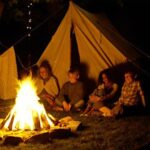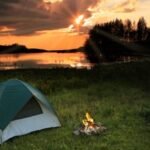If you’re lucky enough to live near a national park, state park, or provincial park, you can get in your car, fly along a highway, and be there pretty quickly.”Being there” (for most people) involves a fair amount of planning especially if this is your first time out and you can escape most of civilization by car. You’ll need basically the same camping equipment for a weekend trip as you would for a week-long trip. The only variable here is food, the longer you’re out, the more you’ll need.But let’s begin with the basics.
The Bureau of Land Management is the United States largest landowner, with approximately 266 million acres in its control. The National Forest Service looks after some 74 million acres, and the National Park Service controls some 84 million acres divided over more than 350 units. With this amount of public land available, it’s likely that the outdoor vacationer will end up selecting a public campground over a private one.
In most cases, you’ll have to purchase a permit for using any public land offering, whether it is for hiking, camping, or canoeing within a public wilderness area. It’s also best to phone ahead and make a reservation for a campsite, especially if you want to camp during a busy holiday like the Fourth of July or Memorial Day. (If you’ve got just a weekend, it’s better to stick close to home.)
Campgrounds do have closing hours; you could be inviting unneeded stress if you get started after work on a Friday in summer (the peak season) with a three-hour-plus drive ahead of you. Not to mention the looming unpleasantry of having to pitch a tent in the dark. Don’t despair; closing hours at campgrounds aren’t that strict. If you arrive at the gate late, you can usually pitch your tent somewhere just for the night and relocate in the morning. (For that matter, you can almost always get to hiking trails the next morning as well.) But why make camp twice? There’s an alternative to a rushed itinerary: Pack up the car the night before and leave early the next morning. You’ll have one less night sleeping under the stars, but you’ll be a happier camper for the experience.
Most likely you’ve been thinking about your outdoor camping trip for some time. Daydreams aside, you’ll need some idea of where you’re going. Brochures, articles in outdoor magazines, or materials from your nearest state park, national park, or provincial park should put you in mind of some good first-time destinations. Most parks and campgrounds have visitor centers chock-full of maps and brochures that describe prominent features in the region and the activities offered by the park. Phone the park and order their brochures in advance.
Choosing a destination means choosing the right kind of campsite too. Some campgrounds offer only primitive campsites with cleared ground for you to set up a tent and a box privy. Other campgrounds offer running water and electrical hookups. And some even offer venues for adventure: Canoes and rowboats may be rented, groomed beaches may be used, and hot showers taken at comfort stations sprinkled throughout the campground. Campground brochures will reveal what’s available just be sure to call ahead to see what’s offered as far as amenities are concerned. They may be key determinants in your choice of a destination.
The really nice thing about camping is that it doesn’t cost that much. Campgrounds charge a nominal fee ranging from $7 to $15 for using a campsite. Sometimes there will be an additional charge for a parking permit if you’ll be leaving your vehicle in a lot while you’re hiking in more remote locations, as well as the price for a backcountry permit. Undoubtedly, you’ll find any price you pay modest, especially when you consider the beauty of the outdoors to be explored.
The National Park Service has a web site where you can find information on most of the 54 national parks in the United States and Virgin Islands. An electronic visitor center describes each park, lists its camping and hiking rules, and offers up a virtual slide show of park highlights you may want to visit.
We recommend Acadia, Grand Canyon, Great Smoky Mountains, Mammoth Cave, Rocky Mountain, Sequoia and Kings Canyon, Shenandoah, Yellowstone, and Yosemite.



